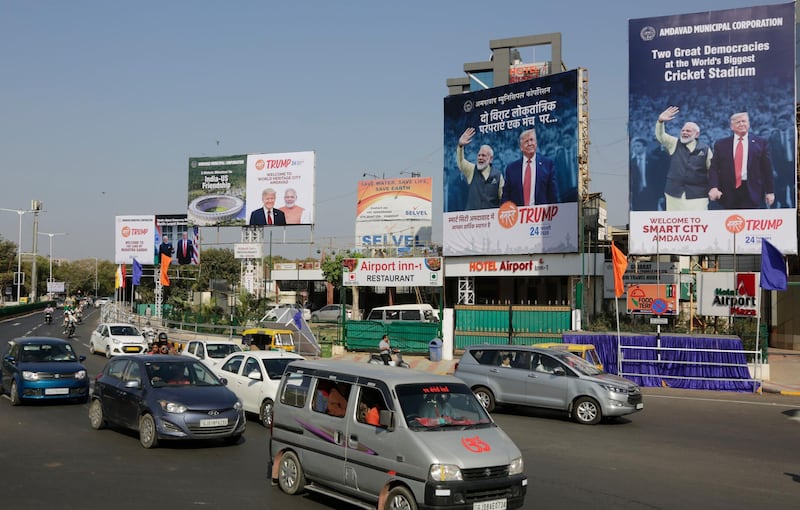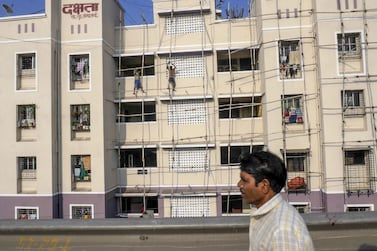On Monday, US president Donald Trump and Indian Prime Minister Narendra Modi will address a rally that is expected to be attended by some 125,000 people at the world's largest cricket stadium. Located in Mr Modi’s home city of Ahmedabad in the western Indian state of Gujarat, the event – dubbed “Namaste Trump” – has similar undertones to the Indian Prime Minister’s welcome in the US last year.
However, this show of camaraderie comes against a backdrop of tense trade relations between the two countries that began in 2018. Rooted in areas ranging from agriculture to medical devices,
trade dispute between the two intensified last year after both the US and India engaged in tit-for-tat tariff actions.
“Trade tensions between the two countries have indeed reached a flashpoint,” says Mahesh Singhi, the founder and managing director of Singhi Advisors, an investment bank headquartered in Mumbai.
It boiled over in June last year when Mr Trump scrapped India’s preferential trade status, which had allowed the country to enjoy duty-free benefits on hundreds of goods exported to America. A total of $5.6 billion (Dh20.6bn) of products exported from India to the US were covered by this programme in 2017. In response, India slapped retaliatory tariffs on 28 products imported from the US, including almonds and apples. Such steps angered both sides.
Such disputes are worrying given that the US is India's largest trading partner. Imports from India totalled $83.9bn in 2018, according to figures from the US government. Top imports from India include precious metals and stones, as well as pharmaceuticals, while major exports from the US to India include mineral fuels and aircraft.
There were initially expectations that Mr Trump's 36-hour visit to India, which will also see him travelling to Agra and New Delhi, would result in some kind of a limited or “mini” trade deal.
But these hopes were dashed when President Trump ahead of the visit said: “We can have a trade deal with India, but I am really saving the big trade deal for later on. I don’t know whether we will have it before the election, but we will have a very big deal with India.” He also said that the US is “not treated very well by India”, in reference to trade, although he was quick to add that he likes Mr Modi “a lot”.
The US leader has long been critical of the imbalance in trade between the two countries. He has previously described India as the “tariff king” because of the high duties it imposes on goods that are shipped in from the US. In 2018, the US goods and services trade deficit with India was $25.2bn, according to the US government.
“Mr Trump wants India to reduce tariffs on many American goods and increase market access on a variety of goods including dairy products which is a major source of livelihood for millions of Indians,” says VK Vijayakumar, chief investment strategist at Geojit Financial Services, based in Kerala. “Some of these demands are not in India’s interests and therefore India is unlikely to cede much ground. A comprehensive trade deal with the US is unlikely now. However, there can be agreements in many areas. India is likely to agree to higher imports of US oil and natural gas to reduce the trade gap.”
India has also downplayed any potential for a trade deal during the visit. “We do not want to rush into a deal as the issues involved are complicated,” India's ministry of external affairs spokesman, Raveesh Kumar, said at a press briefing on Thursday. “We do not want to create artificial deadlines.”
Hopes of a trade deal have faded even further after it emerged that US trade representative Robert Lighthizer - who is in charge of the trade deal negotiations - is not part of the delegation travelling to India.
“My personal view is the meeting between Mr Modi and Mr Trump may turn out to be more of diplomacy signalling relationship between India and the US to others and this meeting may be a prelude for something later as indicated by the US president,” says K Rangarajan, the head of the Indian Institute of Foreign Trade's Kolkata campus.
Both Mr Modi and Mr Trump are well known for their protectionist policies. Mr Modi has endorsed his “Make in India” initiative that aims to boost manufacturing within India; while Mr Trump has long spoken about “America First” and becoming less dependent on imports to generate more jobs for the US population.
“We have low expectations for more substantial progress in trade talks,” writes Shilan Shah, the senior India economist at Capital Economics, in a research note. “Indian policymakers have turned even more protectionist – illustrated by the withdrawal from the Regional Comprehensive Economic Partnership (RCEP) in November.”
The US has also given little indication that it will back down easily.
“We’re only making deals if they’re good deals, because we’re putting America first,” said Mr Trump, speaking at an event in Las Vegas on Thursday. “Whether people like it or not, we’re putting America first.”
There has also been a gradual build-up in friction between the two sides, following other moves.
In 2018, the US raised steel and aluminium duties for countries including India, which angered New Delhi.
Meanwhile, Washington was caught off guard a year ago when the Indian government unexpectedly introduced a new foreign direct investment policy for e-commerce, which included restrictions on discounting. The legislation has affected US retail giants Amazon and Walmart, which have both invested heavily into the e-commerce sector in India.
Washington is also unhappy about India's purchase of a multibillion-dollar missile system from Russia.
More recently, India's finance minister Nirmala Sitharaman, in the annual budget presented at the beginning of February, announced higher tariffs on imports including medical devices and electronics, which has an impact on the US.
The US scrapping India's special trade status last year has irked New Delhi and “India would demand the restoration of preferential trade privileges which facilitated duty-free exports of Indian goods to the US”, says Mr Singhi.
There is some speculation that India may in turn increase its spending on defence equipment from the US.
Despite the friction, the Indian government has been keen to highlight the importance of trade between the two countries.
“The US is India's largest trading partner in goods and services,” said Mr Kumar. “Also do keep in mind that there has been a consistent growth in trade between the two countries over the last few years.”
He added that trade has been growing at more than 10 per cent annually over the past two years.
Maintaining strong relations between the two sides is all the more important given the slowdown in the Indian economy, with GDP growth estimated to have fallen to a more than decade low of 5 per cent in the current financial year to the end of March, according to the India government.
“A trade deal with the US is very important for India now since a boost to exports is crucial to revive economic growth in India,” says Mr Vijayakumar.
And with the US presidential election coming up this year, there is all the more reason not to exacerbate tensions.
“This visit is important for President Trump since the support of the Indian diaspora is crucial in the presidential elections,” says Mr Vijayakumar. He believes that this might help the two sides to make some progress during Mr Trump's trip to India. “Some package is likely to be signed with declaration of a comprehensive deal later.”
Mr Rangarajan says that “both countries understand the importance of mutual relations for smoother trade”.
But some think that Mr Trump's first visit to India may be more about optics.
“India and the US have engaged in dispute resolution consultations at the highest levels,” says Mr Singhi. “There are little chances of both countries achieving a breakthrough in redressing their trade and business differences.”







